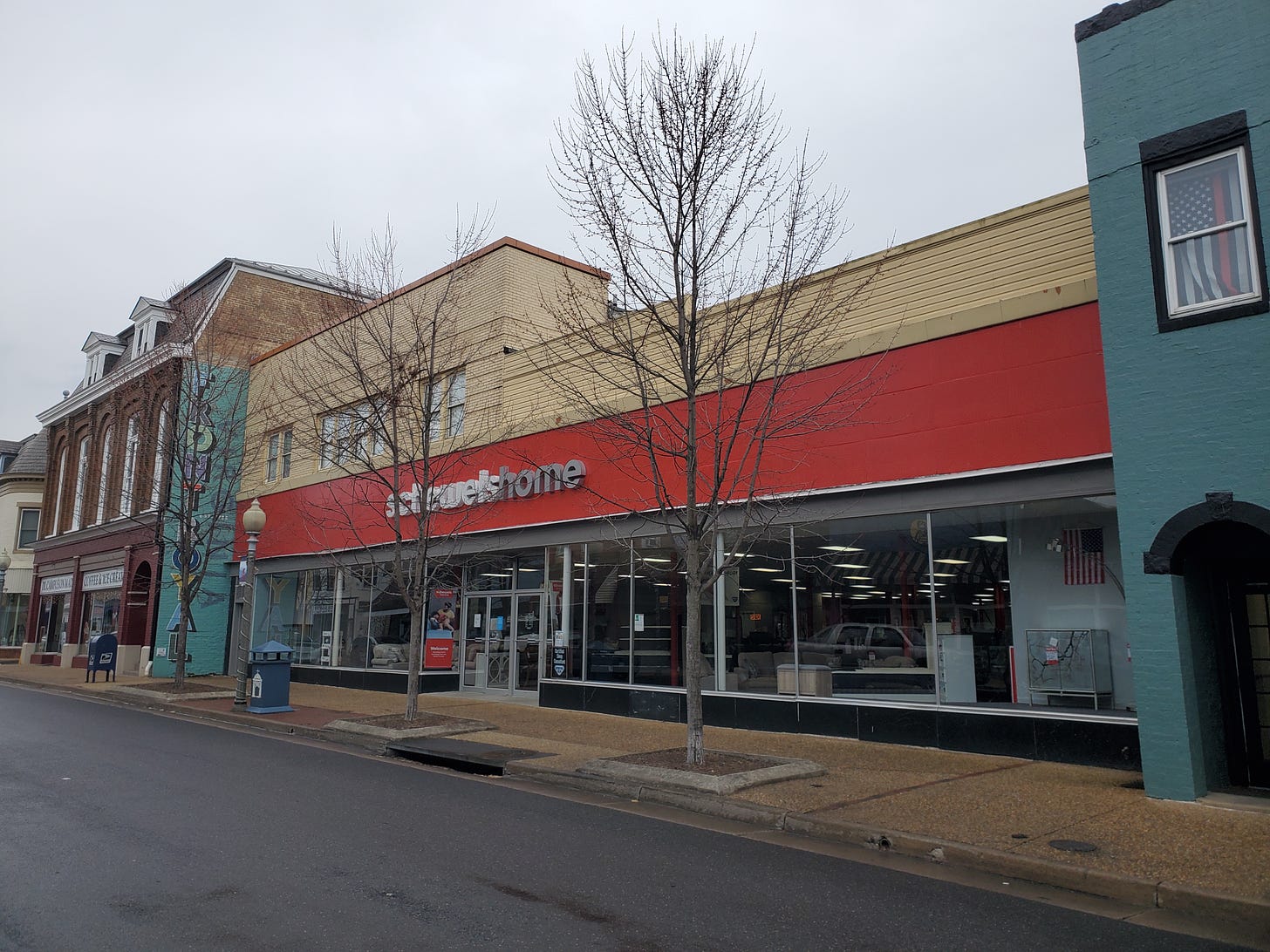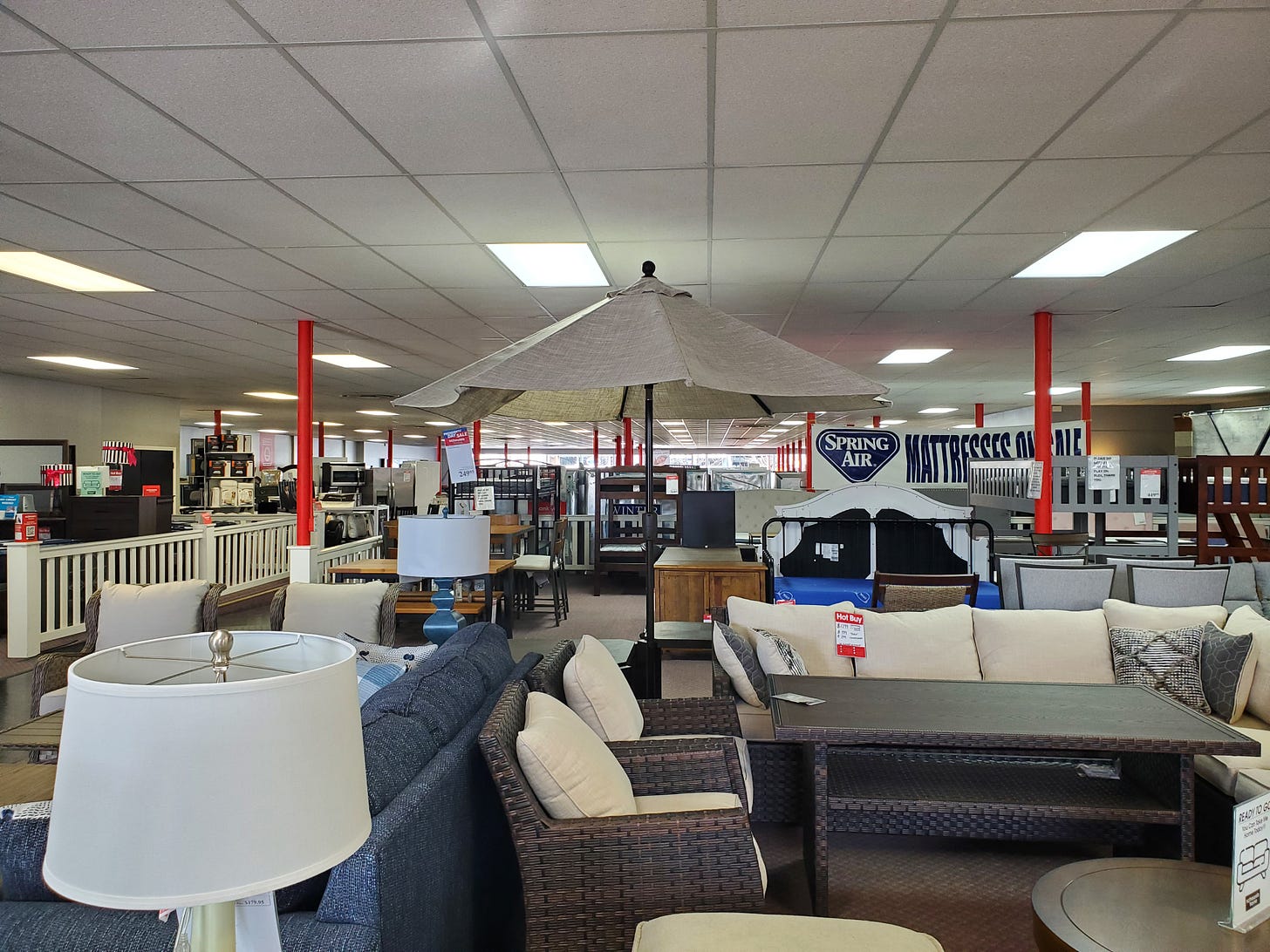Readers: This week marks the completion of the third year of The Deleted Scenes—that’s three full years, every day except Sunday, of thoughtful, illustrated, locally rooted pieces on urbanism and more. I’m offering a 20 percent discount for new subscribers, good until the end of Sunday. If you’ve been on the fence about upgrading to a paid subscription, this is a great time. Your support—whether reading, sharing, or subscribing—keeps this thing going. Thank you! To another year!
I often write about small towns, and my idea that small towns are, or at least began as, cities—that is, not a different kind of place from “the city,” but just a smaller and less intense incarnation of it. I say “began as,” because many small towns these days are either hollowed out or boutiquified—no longer home to the kind of meat-and-potatoes businesses and services they once were. Grocery stores, hardware shops, a lot of old public schools and churches, and other everyday businesses and services largely migrated out to the suburbs, sometimes to the edge of town and sometimes beyond city limits entirely.
And another kind of business that disappeared from American Main Streets was the variety store.
In the golden age of American urbanism, lots of small cities had at least one department store—often more than one. That was the subject of a previous entry in this series, on department stores in Plainfield, New Jersey.
But even below that scale, there were similar stores in small towns, which were too small for true department stores. These were the five and dimes or variety stores—similar in nature to the modern dollar store but often much nicer. Many had lunch counters, for example. An old-school small-town variety store was essentially a department store (with a more discount orientation) scaled to the Main Street pattern.
There were a few of these chains, with the best known probably being the S.S. Kresge chain (the forerunner of Kmart) and Woolworth’s. For a little bit on Kmart’s long history, read this piece. But today I’m focusing on Woolworth’s.
It’s almost hard to imagine how ubiquitous these stores were, and that a town of just a few thousand people could support at least one of them. They were not small, either by the standards of the time or the typical size of a Main Street storefront: somewhere around 20,000 square feet. Many were two floors.
It turns out that I’ve been in at least one old Woolworth’s store before, though I didn’t know that’s what it had been. The last of them closed by the late 1990s—far later than I would have guessed, even though I was alive at the time. A little aside here—this is about the time a lot of old-school chain supermarkets in old towns closed too. In fact, some of them were still being built and opened in the 1960s, in downtown locations. It’s fascinating to me how long everyday retail held on in a small-town setting. Some semblance of that old economy persisted well into the period when it was generally considered bygone.
Look at this tidbit from the Wikipedia article on Woolworth’s:
On March 17, 1997, Wal-Mart replaced Woolworth’s as a component of the Dow Jones Industrial Average. Analysts at the time cited the lower prices of the large discount stores and the expansion of supermarket grocery stores – which had begun to stock merchandise also sold by five-and-dime stores – as contributors to Woolworth’s decline in the late 20th century.
Modern large supermarkets with drug and variety departments were still something people talked about as a retail concept and not just what supermarket meant. All of this is hardly more than 25 years ago.
Woolworth’s declared bankruptcy and closed all remaining stores in 1997. There were still 400 of them left at that time; some were newer strip-plaza locations, but many were legacy small-town locations. The chain folded under the same pressures as Ames, Bradlees, Caldor, Kmart (in much slower motion), and any number of other discount chains, from the smaller variety-store end to full discount department stores.
In fact, like Kmart, Woolworth’s was actually both of these; the variety store chain introduced a full discount department store concept, Woolco, in 1962. That happens to be the same year the first Kmart store opened. Both Kmart and Woolco appeared more than half a century into the lives of the parent companies.
So now I’ll show you the Woolworth’s I’ve been in—an expansive two-story space (ground level and lower level!) in Somerville, New Jersey. Any conspicuously large Main Street storefront with more than one level very likely was a Woolworth’s or one of the similar stores in that period.
It used to be a cavernous antique store, a very frequent second life for old Main Street stores in a slump. Somerville is hopping these days, but in the 1990s, it was aging, with the general end of the old small-town economy coinciding with a recent new mall just outside city limits. I remember an old-school Zenith television repair sign hanging outside one of the storefronts, and more than one antique shop.
This is what it looked like, which is probably pretty much how it looked as a Woolworth’s:
And here it is today. The exterior has gotten a little upgrade and it’s now no longer a store at all, but a brewpub. Here’s a story about the development of the brewpub.
Madison, New Jersey—about 10,000 people in 1950—had one too. I went to college near here, and walked up and down Madison’s Main Street dozens, maybe hundreds of times. I had no idea this building I’ve popped into once or twice, now divided into multiple storefronts, was a Woolworth’s. Here’s a photo of it then. And here it is today:
Westfield is another town I’ve been through and in a few times. There’s a Trader Joe’s there, within the street grid, a throwback to the days when every such town had a small supermarket. Westfield is famous for its affluence and NIMBYism, although it’s a low-intensity urban place on a rail line into New York. It has the bones of a city, and strikes me as exactly the sort of place where new development can fit in.
One of my general arguments is that not only do these towns make sense as places for new growth, but that such growth would put them back in continuity with their own history. These old small towns were never supposed to be “finished”—people in the old days wanted their towns to get bigger!
That’s part of why the old retail in towns interests me—because it proves these were places people lived and ran errands unselfconsciously. They weren’t static lifestyle amenities for suburbanites.
Westfield, as it happens, was one of those towns that kept its Woolworth’s to the very end. In 1997, its branch closed with the chain, after 67 years in business! Let me give you another neat fact: Walmart—founded, along with Kmart and Woolco, in 1962—is younger today than the Westfield Woolworth’s store was in 1997!
Here’s a digitized newspaper clipping about the closure. The store even still had its lunch counter, and people in the community missed it. It wasn’t just a fun or cheap store or a place with memories—it was everyday business scaled to a built environment we love. A town isn’t just land use. It’s land use and commerce scaled to fit. Urbanism is not just about getting land use right, but about rebuilding an economy that fits urban places—whether cities or towns.
Here’s the old Westfield Woolworth’s:
It’s now, not unfittingly, a retro video game arcade. A point of trivia: there’s also a Yestercades in Somerville, though obviously not in the old Woolworth’s. (Here, also, is a real-estate brochure for the Westfield property before it became Yestercades.)
Maybe this sort of thing: brewpubs and other elevated, local drinking venues, arcades, and various sorts of specialty shops and restaurants—plus new housing—is a new, durable, small-town economy. I hope so.
Bonus: here’s Roanoke, Virginia’s Woolworth’s, apparently now an apartment building with an adapted sign, called The Woolworth!
And here’s one in Southeast D.C. The building is at least as old as the 1930s, and it also appears to retain some elements of the original sign:
I hoped to find an old Woolworth’s in Northern Virginia, but it doesn’t look like any of our small towns or cities—Fairfax, Falls Church, Vienna, Leesburg, a couple others—had one. I wasn’t able to dig one up, anyway, but there certainly would have been other similar stores in those places, like Ben Franklin (which improbably still has three franchisees in business!). In any American small town, you’re almost guaranteed to find buildings that once housed 1) a grocery store and 2) a variety store.
One more note on Virginia: this is an old department or variety store in Front Royal, Virginia, which certainly fits (or once fit) into the category of stores I’m writing about here:
Here’s a great article with some more New Jersey then-and-now locations and a bunch of great photographs. (Based on one of these photos and a reference to 1999, it looks like some of these stores may have stayed open until that year, two years after the company’s bankruptcy. Odd detail which isn’t noted in other sources.)
And that article makes this interesting observation:
All the merchandise at Woolworth’s was laid out on tables and in bins for the public to inspect at leisure. Customers — many, frankly, from lower income brackets, and liable to be self-conscious about it — no longer had to risk humiliation by asking a snooty sales clerk to take something down from the shelf.
As with supermarkets—which are now missing a small-format segment and leaving a lot of opportunity on the table, I believe—discount stores got bigger and bigger, and more and more scaled to driving. We’ll see if the old way has a future. If it exists—or if it existed—it’s possible.
Related Reading:
Kinney Shoes’ Architectural Afterlife
Thank you for reading! Please consider upgrading to a paid subscription to help support this newsletter, discounted just this week! You’ll get a weekly subscribers-only piece, plus full access to the archive: over 900 pieces and growing. And you’ll help ensure more like this!












This kinda touches on your piece about urbanism and families - a woolworth's you could walk to is incredibly useful for families. a brewpub in downtown is probably incredibly attractive for younger urbanists. an arcade is a place a lot of kids USED to hang out - but nowadays, it would appeal more to nostalgic millenials and Gen Xers than young kids.
Not saying "tear up the brew pubs" - people go downtown to have fun, after all. But family urbanism, in small towns and medium suburbs should mean woolworth's, and maybe modern arcades, and karate dojos. And sure, brewpubs are great too.
I went to that Woolworth in Somerville growing up in the 80s. Memories are hazy but it seemed pretty run down even back then, long before the closure. But this was a transition time - many of the retailers of my parents generation were still hanging on either in a downtown or in an earlier smaller shopping center. But they would soon be gone.